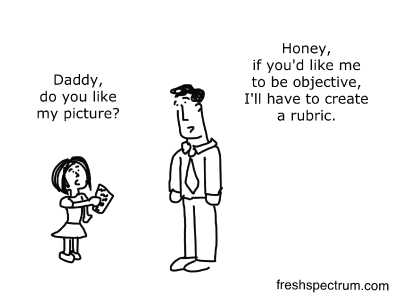
Uses
 For data collection through observation or other generally qualitative methods, rubrics provide a quick way to classify or categorize data based on a set of pre-determined criteria. Criteria-based rubrics can also help with data synthesis from a variety of sources so that the data work collectively toward an answer to an evaluative question (Davidson, 2005).
For data collection through observation or other generally qualitative methods, rubrics provide a quick way to classify or categorize data based on a set of pre-determined criteria. Criteria-based rubrics can also help with data synthesis from a variety of sources so that the data work collectively toward an answer to an evaluative question (Davidson, 2005).
Rubrics can speed up data collection and help reduce subjectivity while also increasing the likelihood that everyone who collects data will be looking for and recording approximately the same thing. (This is also known as inter-rater reliability.)
 Examples and More Information
Examples and More Information
E. Jane Davidson’s work around actionable evaluation makes a compelling case for rubrics as a meaningful conglomeration of criteria that can help answer questions that might seem difficult to answer through data collection (Davidson, 2005).
A great example of this in the prevention world can be found in Ohio where they use a rubric for assessing grantee capacity around a variety of prevention principles, skills, and orientations (Stevens & Ortega, 2011). The rubric is based on a tool originally produced in the Virginia Sexual and Domestic Violence Action Alliance’s Guidelines for the Primary Prevention of Sexual Violence & Intimate Partner Violence (2009) and has criteria to measure domains such as program comprehensiveness, socio-cultural relevance, sustainability, and evaluation use. You can check the rubric out on the website for Ohio’s Empowerment Evaluation Toolkit housed on the website of the Ohio Domestic Violence Network (Stevens & Ortega, 2011).
The Center for Whole Communities developed a rubric for evaluating deep community change work that focuses on a variety of domains relevant to sexual violence prevention work, including community building and justice and fairness (Center for Whole Communities, 2007). There’s even an online tool to facilitate using this rubric with community groups.
Other preventionists have used rubrics to assess facilitation skills of a person implementing education-based prevention programming. Activity-based evaluation/assessment also relies on rubrics and other scoring tools to assist with observational data collection (Curtis & Kukké, 2014).
References
Center for Whole Communities. (2007). Whole Measures: Transforming our vision of success. Retrieved http://measuresofhealth.net/additional_resources/moh_download.shtml
Curtis, M. J., & Kukké, S. (2014). Activity-based assessments: Integrating evaluation into prevention curricula. Retrieved from the Texas Association Against Sexual Assault: http://www.taasa.org/wp-content/uploads/2014/09/Activity-Based-Assessment-Toolkit-Final.pdf
Davidson, E. J. (2005). Evaluation methodology basics: The nuts and bolts of sound evaluation.
Stevens, A. B., & Oretga, S. (2011). Empowerment evaluation toolkit. Retrieved from the Ohio Domestic Violence Network: http://www.ncdsv.org/images/ODVN-ODH_EmpowermentEvaluationToolkit_12-2011.pdf
Virginia Sexual and Domestic Violence Action Alliance. (2009). Guidelines for the primary prevention of sexual violence and intimate partner violence. Retrieved from http://www.communitysolutionsva.org/files/Prevention_Guidelines_20092.pdf
| Back | Index | Next |
